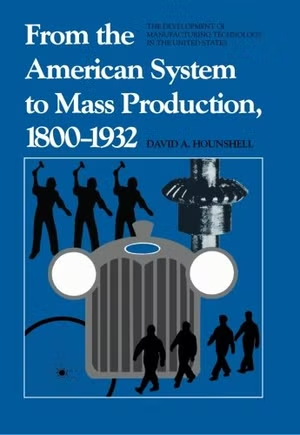In “From the American System to Mass Production, 1800-1932” David Hounshell offers a well researched perspective on the evolution of manufacturing methods in Great Britain and the United States.
“From the American System to Mass Production, 1800-1932”
by David Hounshell
 I found the American System to Mass Production by David Hounshell insightful. He outlines a three step evolution in manufacturing:
I found the American System to Mass Production by David Hounshell insightful. He outlines a three step evolution in manufacturing:
1. British factory model: Artisans working in cottages to working under one roof; organized by departments.
2. American System Standard parts / interchangeable parts driven initially by needs of soldiers in field to scavenge parts for repairs for damaged pistols and rifles
- Enabled by precision machining and specialized jigs at each station or part of procurement
- Made part manufacture more exacting but vastly simplified final assembly process
3. Mass production
- Step 1: Organized workers by role in assembly sequence not department to simplified material flow
- Step 2: Added material handling, changing out men with carts for conveyor belts and standard material handling to have work flow to each station.
- Step 3: Ford optimized around Model T architecture, GM introduced regular model year changes and relied on more general purpose machines spaced farther apart to allow for upgrades and changeouts.
- End result – general purpose machine tools organized by assembly flow and connected by automated material flow.
Some Excellent Books on How Work is Organized and Products Evolve
“From American System to Mass Production, 1800 to 1932” by David Hounshell
I learned a lot about the evolution of manufacturing from this book
“Science and Corporate Strategy: Du Pont R and D, 1902–1980” by David Hounshell
I found this history of chemical breakthroughs from 1900-1980 fascinating.
“Cognition in the Wild” by Edward Hutchins
Interesting insights on how humans an machines jointly manage large structures,
for exampling navigating and aircraft carrier.
“Turning Points in Western Technology” by Donald Cardwell
The Dark Ages were a time of innovation, distributing benefits much more widely than the Golden Ages of the Greeks or Romans.
“Men Machines and Modern times” by Elting Morrison
An excellent view of how innovators bring change to organizations, the chapter on “Gunfire at Sea” is outstanding.
“Corporation Man” by Anthony Jay
Thought provoking insights on organizational dynamics and self-organizing teams
“Mastering the Dynamics of Innovation” by James M. Utterback
Well researched and detailed perspective on how products and industries evolve.
Related Blog Posts
- Joel Mokyr on Creative Forces and Cardwell’s Law
- Chalk Talk: S-Curve for Technology Investment
- Eben Moglen: Steel to Software to Collaboration
- Scott Berkun: How to Translate Observations and Creative Insight Into a Solution
- Chalk Talk: Where is your team in the explore exploit continuum?
- Intrapreneur Mindset and Key Skills
- Developing a New Product? Key Questions to Ask
- 21 Great Questions for Developing New Products
